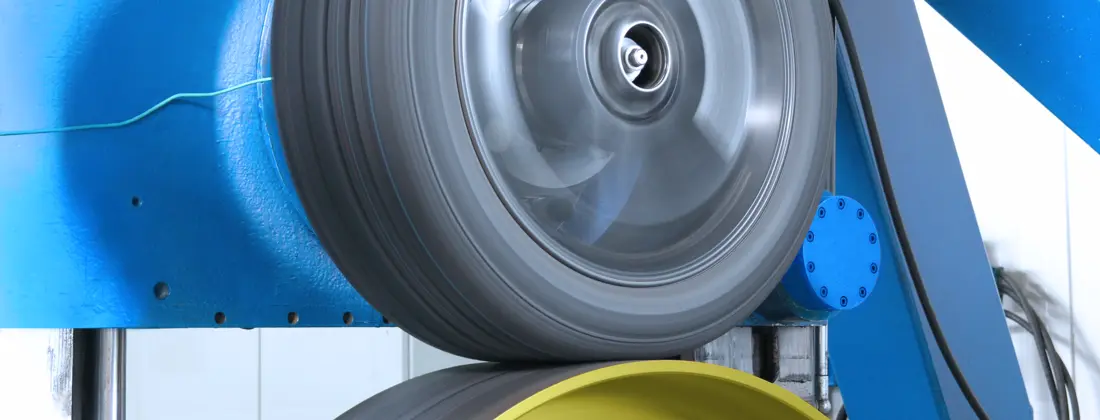EN 14245 Tyre Road Noise Emission Test
The EN 14245 standard provides a comprehensive framework for assessing the road noise emission of tyres, which is critical for both environmental and safety considerations. This test ensures that tyre manufacturers meet stringent noise standards set by regulatory bodies across Europe to reduce noise pollution caused by road traffic.
Compliance with this regulation not only aids in minimizing adverse effects on human health but also helps tyre manufacturers stay competitive in the market. The test evaluates the sound pressure level produced by tyres when they are in motion, ensuring that they meet the specified limits set out by EN 14245. Understanding the principles behind this test is essential for quality managers and compliance officers within the automotive industry.
For R&D engineers involved in tyre development, this standard provides a clear roadmap to follow during product design iterations. By adhering to these guidelines, they can ensure that their innovative designs are not only safe but also environmentally friendly. For procurement teams responsible for selecting suppliers, understanding EN 14245 ensures that they choose partners who adhere to high standards of quality and sustainability.
Before diving into the specifics of how this test is conducted, let us briefly discuss its importance in context with other aspects of tyre performance. While road noise emissions are one crucial factor, there are others such as fuel efficiency, wear resistance, traction, etc., that contribute to overall tyre effectiveness. However, reducing noise pollution remains a priority due to its direct impact on public health.
The EN 14245 test procedure involves several steps aimed at accurately measuring the sound pressure levels generated by tyres under controlled conditions. These steps include preparing the test specimens (tyres), setting up the required equipment, conducting the actual measurement process, and analyzing results against predefined criteria. Each stage requires meticulous attention to ensure accurate readings.
To better understand these stages, consider a hypothetical scenario where a tyre manufacturer wants to validate compliance with EN 14245 before releasing its product into the market. They would begin by selecting appropriate samples representing various types of tyres they produce. Then, using specialized noise measurement equipment, they would simulate real-world driving conditions to capture sound pressure levels accurately.
It is important to note that while this description provides a general overview of what constitutes an EN 14245 tyre road noise emission test, actual procedures may vary slightly depending on specific requirements stipulated by different regions adopting the standard. Nonetheless, adherence to international standards like EN ensures consistency across borders and fosters trust among consumers.
Scope and Methodology
| Aspect | Description |
|---|---|
| Test Environment | The test should be conducted in an open road environment that simulates real-world driving conditions. This includes factors such as speed, traffic density, and weather. |
| Noise Measurement Equipment | A calibrated sound level meter capable of measuring sound pressure levels at specified frequency bands is required for this test. |
| Specimen Preparation | The tyres to be tested must undergo rigorous preparation processes, including cleaning and conditioning, to eliminate any external variables that could affect measurement accuracy. |
| Data Acquisition | All relevant data points are recorded throughout the testing process. This includes initial setup details, operating parameters used during tests, final results obtained after all trials have been completed. |
The methodology outlined in EN 14245 emphasizes precise control over environmental variables to ensure accurate measurements. By following these guidelines closely, laboratories can achieve reliable outcomes that meet regulatory expectations.
Eurolab Advantages
EuroLab stands out as a premier provider of EN 14245 tyre road noise emission tests due to its extensive experience and cutting-edge facilities. Our highly skilled technicians possess deep knowledge of automotive testing standards, enabling them to deliver accurate results consistently.
- State-of-the-art equipment: We utilize the latest technology in sound measurement instruments that adhere strictly to international standards.
- Experienced staff: Our team comprises experts with years of experience in tyre testing and quality assurance practices.
- Rigorous quality control: Every aspect of our operations is subject to stringent checks ensuring compliance with all relevant regulations.
- Comprehensive reporting: Beyond mere numerical outputs, we offer detailed reports that interpret findings within broader contexts, helping clients make informed decisions.
Choosing EuroLab for your EN 14245 tyre road noise emission tests guarantees peace of mind knowing that you are working with professionals committed to excellence in every project they undertake. Whether you need certification or merely want verification services, our dedicated team is here to assist you.
Quality and Reliability Assurance
- We employ rigorous quality control measures at every stage of the testing process.
- All personnel involved in testing undergo regular training sessions to stay updated on advancements within their field.
- The laboratory maintains ISO 17025 accreditation, ensuring that our practices meet international standards for competence and capability.
- Our calibration procedures follow strict protocols defined by recognized organizations such as NIST (National Institute of Standards & Technology).
These commitments ensure that the results produced are reliable and can be trusted by all stakeholders involved in tyre development, production, and regulation.





